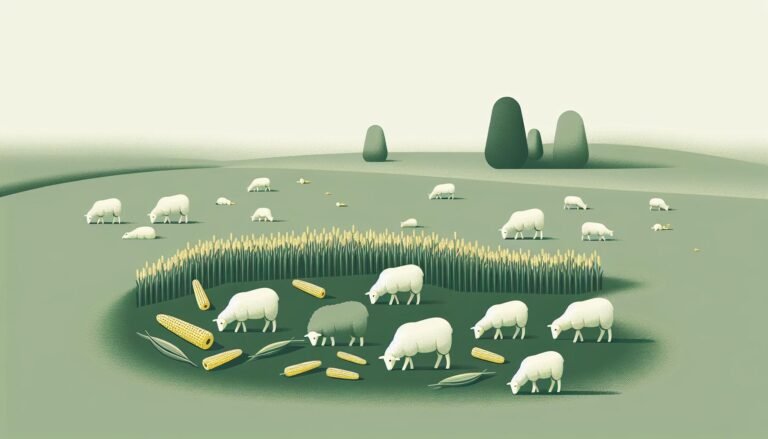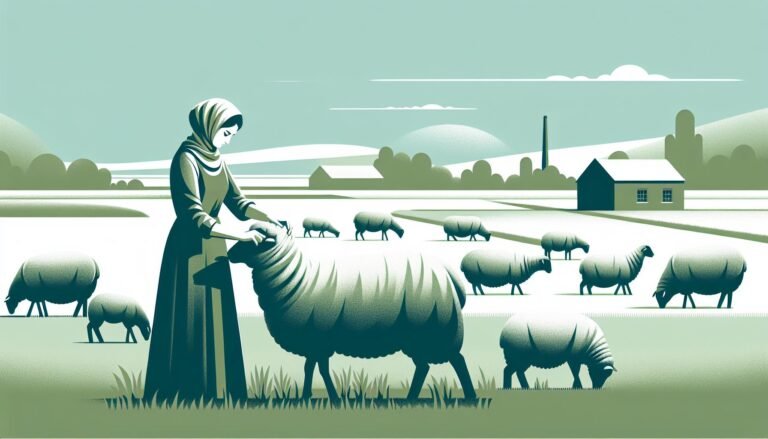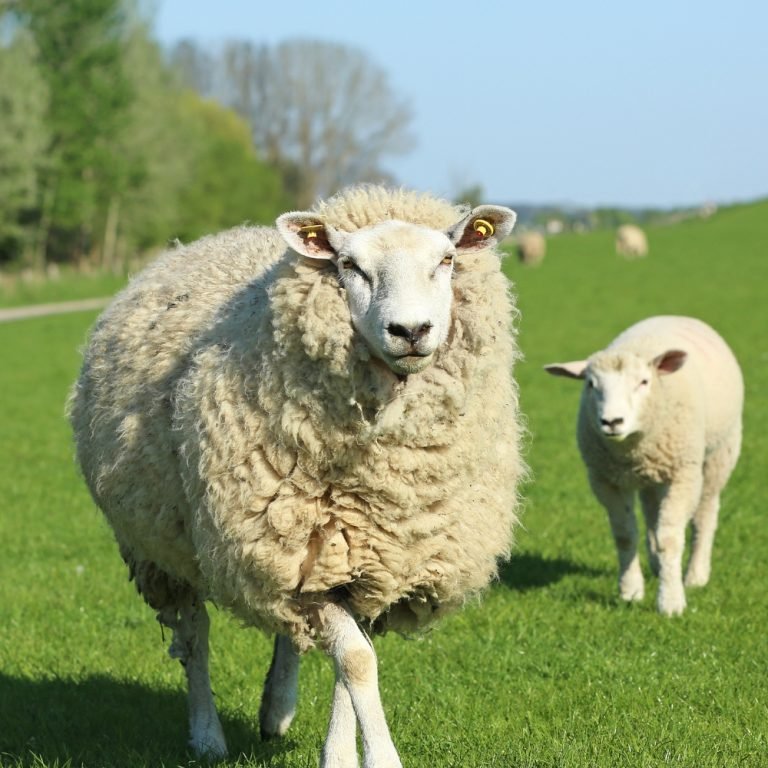Understanding the Benefits: Why Farmers Separate Sheep from Goats
Ever wondered why farmers often separate sheep from goats? It’s not just an old wives’ tale or a random decision. In fact, it’s a strategic move rooted in the distinct characteristics and needs of these two animals.
Sheep and goats may look similar at first glance, but they’re as different as chalk and cheese. From their feeding habits to their social behavior, there’s a world of difference between them. Understanding these differences is crucial for farmers to manage their livestock effectively.
So, it’s not just about keeping the peace in the farmyard. It’s about optimizing the health and productivity of both species. Stay tuned as I delve into the nitty-gritty of why farmers make it a point to separate sheep from goats.
Key Takeaways
- Sheep and goats have distinctive characteristics that require different care routines. Sheep are group-centric and produce wool, necessitating regular shearing, whereas goats are independent and adventurous with a coat that demands less maintenance.
- Feeding habits significantly differ between sheep and goats. Sheep adhere strictly to a pasture grass and hay diet, while goats’ adventurous eating patterns include a wider variety of plants. This disparity makes a uniform diet impractical, leading to farmers’ decision to separate them.
- Sheep and goats portray distinct social behaviors influencing herd management. The sheep’s herd mentality requires shepherds for guidance and protection, while the goats’ independent nature often leads to escapades, making separate housing necessary.
- Breeding practices also differ between sheep and goats. Goats breed after reaching seven months of age while sheep reach sexual maturity at approximately five months. This varying maturity rate necessitates strategies for enhanced productivity.
- Strategically, separating sheep and goats optimizes their health and productivity on the farm. This includes providing an optimal diet, reducing the risk of injuries due to conflicts, and maximizing the results of species-specific breeding practices.
The Distinct Characteristics of Sheep and Goats
In evaluating the reasons behind separating sheep from goats, one must first understand their distinctive characteristics. Though they might appear similar at first glance, sheep and goats are distinctly different in both behavior and needs.
Sheep, for instance, are typically more timid and prefer to stay in a group. This herd mentality is their coping mechanism for dangerous situations. Sheep also produce wool, which requires regular shearing to prevent health issues like heat stress or flystrike. Wool production in sheep necessitates a specific management strategy different from that of goats.
On the other hand, goats are quite curious and independent, often wandering off on their own. They have adventurous eating habits, consuming a wider variety of plants than sheep, which can make managing their diet a particular challenge. Also, goats have hair, not wool, which requires less maintenance.
The table below summarizes these differences:
| Sheep | Goats | |
|---|---|---|
| Behavior | Group-centric, timid | Independent, curious |
| Coat | Produces wool, needs regular shearing | Has hair, requires less maintenance |
| Dietary Pattern | Selective eater | Adventurous eater |
Mindful of these disparities, it’s easy to see why farmers choose to manage these species separately. The varying needs of sheep and goats often translate into distinctive care routines, making their co-habitation somewhat impractical. By recognizing their different characteristics, farmers can tailor their management practices to ensure optimal health and productivity for each species. This acknowledgement of individual needs within a herd or flock both respects the animals’ characteristics and ensures that one group’s needs don’t infringe upon the needs of the other.
Now that we’ve established the different traits of sheep and goats, let’s delve deeper to see how these characteristics influence farmers’ management decisions. By effectively using this information, farmers can indeed optimize their livestock’s potential to great extents.
Feeding Habits: Why Separation is Important
Sheep and goats have notably different feeding habits, a fact that significantly sways farmers’ decision to separate them. While they belong to the same family and share some common traits, their dietary patterns paint a stark contrast.
Goats, known for their robust spirit, are natural explorers. They’ll nibble on almost anything, from leaves and twigs to homegrown vegetation. This exploratory tendency is a double-edged sword. While it caters well to their survival instinct, it often leads them into mischief and poses threats to their health.
On the other hand, sheep adhere to a much stricter dietary regimen. Preferring pasture grass and hay, they spend the majority of their time grazing. Unusual or unfamiliar foods can upset their stomachs, leading to health complications.
These contrasting feeding habits create a significant challenge for farmers looking to co-habit sheep and goats.
| Sheep | Goats | |
|---|---|---|
| Diet Preference | Grass, hay | Leaves, twigs, and other homegrown vegetation |
| Feeding Tendency | Strict dietary regimen | Adventurous, varied diet |
Attempting to craft a universal diet to accommodate both species could lead to malnutrition or sickness for either one. To navigate around this, farmers often opt for species-specific enclosures. Here, they can tailor feeding strategies to the unique dietary requirements of each, promoting healthier, happier livestock.
Suppose some farmers do decide to try to cohabitate the two species. They’ll need to implement a comprehensive rotation system, ensuring each species gets access to suitable food sources.
Accepting these differences can lead to a more focused approach to livestock care. Farmers who recognize and adapt to these unique feeding habits ensure more balanced diets, improved health, and ultimately higher productivity for their animals.
Optimal livestock management begins with understanding every detail of animal behavior, even the simple act of eating. And as we’ve learned, for sheep and goats, there’s more to feed time than meets the eye.
Social Behavior: Managing the Herd
In addition to their feeding habits, sheep and goats also demonstrate distinct social behaviors that influence how farmers manage their herds. Sheep are flock animals and prefer to stay grouped together. This flocking instinct is a defense mechanism against their predators. On the other hand, goats are more independent and adventurous, often wandering off from the herd. These behavioral tendencies pose unique challenges when it comes to herd management.
Sheep, known for their tightknit herd mentality, rely heavily on shepherds to guide and protect them from harm. That’s why I always say, “you can’t treat them like goats”. A uniform approach towards both can result in an uncontrolled herd which isn’t good for farm productivity.
Speaking of the wild children of the farm, goats, while they’re a delight with their antics, they’re a handful to manage. Their innate inquisitiveness leads them to explore areas outside of their designated enclosures. This independent streak often translates into a knack for escaping, resulting in frequent headaches for shepherds.
So what’s the farming solution? Species-specific housing isn’t just about dietary needs. Proper enclosures are more crucial for goats while larger grazing areas work best for the sheep. It’s essential to know these differences when managing diverse livestock.
That’s not all, there’s more to consider – breeding practices. Goats and sheep have different gestation periods. Goats usually breed after reaching 7 months of age while sheep reach sexual maturity at around 5 months. This discrepancy in maturity between the two adds another twist to herd management.
| Goats | Sheep | |
|---|---|---|
| Independent | Yes | No |
| Gestation period | After reaching 7 months | After reaching 5 months |
Understanding your herd’s social behaviors is beneficial. It can ultimately lead to healthier animals, higher farm productivity, and obviously a happier farmer.
Health and Productivity: The Benefits of Separation
Separating sheep and goats isn’t just a saying — it’s a crucial strategy that can transform the health and productivity of a farm. Each of these species has unique health needs and behaviors that dictate their diet, living conditions, and handling methods. Let’s get into the details to better understand why it’s an effective strategy.
First and foremost, sheep and goats have distinctly different dietary requirements. Sheep have adapted to thrive on a diet rich in grass while goats have evolved to browse and therefore prefer a diet rich in brush and other plants not typically consumed by sheep. Overlapping feeding areas can lead to dietary imbalances and health challenges for both species. By separating the two, farmers can ensure that each species gets its optimal diet leading to healthier animals.
In terms of social behaviors, both species interact differently within a group. Goats tend to establish a dominance hierarchy, which can lead to increased aggression and bullying. Sheep, on the other hand, are more docile and move in herds for safety. Mixing sheep and goats becomes a challenge — conflicts can escalate, leading to injuries and overall distressed behavior in the farmyard. Separating them allows each group to interact in ways that are natural and beneficial to their respective species.
Additionally, breeding practices that suit one species might not necessarily benefit the other. Seasonal differences in reproduction can often cause poor results if handled incorrectly. By understanding and respecting these differences, farmers can maximize productivity and avoid health complications.
To summarize, there’s an array of reasons why separation is a beneficial strategy for farmers. It allows for better health, increased productivity, and overall harmony in the farmyard. The feeding habits, social behaviors, and breeding practices of goats and sheep are unique to each species and should be considered when devising their management and care.
To illustrate the impact of separation on the farm’s overall health and productivity, I’ve put together a table showcasing the advantages:
| Aspect | Without Separation | With Separation |
|---|---|---|
| Health | Potential dietary imbalances, risk of injury due to conflict | Optimal diet for each species, reduced risk of injuries due to conflicts |
| Productivity | Potential poor breeding results due to mixed species and seasonal differences | Maximization of breeding results due to species-specific handling |
| General Farm Management | Increased stress due to conflicting behaviors | Smoother operation and less conflict due to species-specific management |
Conclusion
So, it’s clear that separating sheep and goats is a smart move for farmers. It ensures each species gets the right diet and social interaction, leading to healthier, happier animals. It also makes breeding more efficient and avoids potential health complications. In essence, this separation strategy boosts productivity and brings harmony to the farmyard. As we’ve seen, it’s not just about keeping the peace – it’s about optimizing the overall health and productivity of the farm. This is why farmers separate sheep from goats, and why it’s so important to understand the unique needs of each species.







